Nikon D5100 Review
Nikon D5100
Nikon’s latest advanced entry-level DSLR offers high-end specs and also benefits from a high-res articulated monitor. Could it be Nikon’s best entry-level DSLR yet?
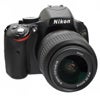
Verdict
Pros
- Hi-resolution articulated monitor
- Easy to use
- Much improved live view AF
Cons
- Special Effects a bit limited
- No wireless flash control/DoF preview
Key Specifications
- Review Price: £730.00
- 16-megapixel CMOS APS-C sensor
- Nikon EXPEED 2 image processor
- 3in, 921k-dot articulated monitor
- 1080p Full HD movie recording
- Expanded sensitivity range of ISO 100 to 25,600
Turning straight to the headline specs, the D5100 employs the same 16.2-megapixel, DX-format CMOS sensor found in the D7000. While it’s not quite class-leading in terms of resolution (that honour goes to the 18-megapixel Canon EOS 600D), it does represent a considerable upgrade over the 12-megapixel sensor used in the D5000, and is also a step up from the 14.2-megapixel chip found inside the D3100.
Furthermore, the D5100 also benefits from Nikon’s latest EXPEED 2 image processor, first seen in the D3100 last year and then in the D7000, but which was not present when the D5000 was launched in 2009.
Along with faster processing times, better battery performance and the ability to record 14-bit (as opposed to 12-bit) Raw files, the new processing engine is able to deliver a maximum continuous shooting speed of 4fps – a slight improvement over the D3100’s 3fps, but not quite up there with the 6fps of the D7000. Compared to its competitors, this puts the D5100 somewhere in the middle; the Canon EOS 600D is a tad slower at 3.7fps, the Pentax K-r faster at 6fps, and the Sony A580 faster still at 7fps.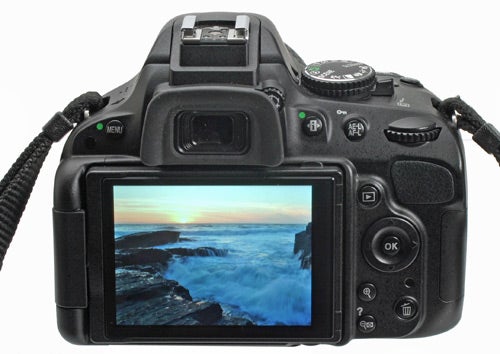
Since the arrival of the D3 and D300 in 2008, Nikon has deservedly gained a reputation for producing DSLRs able to shoot in low-light at high sensitivities while delivering images largely free of intrusive, image-degrading noise. The professional-grade D3s currently leads the way here with a top (expanded) ISO setting of 102,400, but models further down the line are increasingly benefitting from Nikon’s expertise in this field.
The D5100 offers a sensitivity range that stretches from ISO 100-6400 in standard mode, stretching to a maximum extended setting of ISO 25,600. If that’s still not quite enough, you can also call upon a ‘Night Vision’ option that pushes the sensitivity up to ISO 102,400, although these images can only be recorded in monochrome and are, as you might expect, super grainy in appearance.
A few compromises have had to be made elsewhere in the Nikon in order to keep costs down, and to ensure there’s clear daylight between the specifications and feature-set of the D5100 and D7000. The D5100 therefore retains the 11-point autofocus module and 420-pixel metering sensor of the D3100 and D5000. Of these 11 AF points only the central one is a cross-type with the other 10 points being of the linear variety. There’s no internal AF motor either, which means only Nikon AF-S and AF-I lenses will autofocus. Other lenses will have to be focused manually.
Likewise, the D5100 is wrapped in the same polycarbonate casing of cheaper Nikon models, rather than the magnesium alloy cage of the D7000 and above. This plastic outer shell is finished with a slight mottled effect to give it a metallic look. 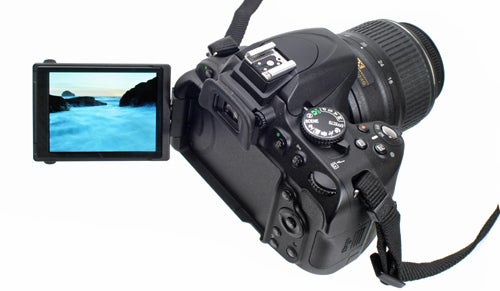
Elsewhere, things are very much as one might expect of an advanced entry-level DSLR from Nikon -¬ the full suite of Program, Aperture-priority, Shutter-priority and Manual shooting controls are present, as is a fully automatic mode, a forced flash-off mode and a selection of scene modes. One thing new addition to the shooting mode dial is the Special Effects option. This is basically a range of digital filters ¬– such as the aforementioned ‘Night Vision’ extended-ISO option – that can be selected to give your images a unique look. We’ll have more to say about these later in the review.
As with all recent Nikon DSLRs the D5100 offers the full range of Picture Controls that allow you to choose how JPEGs will be processed by fine-tuning individual elements such as saturation, sharpness, brightness and contrast. While the default settings are limited to a choice of: Standard, Neutral, Vivid, Monochrome and Portrait, all of these can be individually edited, with a further option to add your own custom profiles if you like. 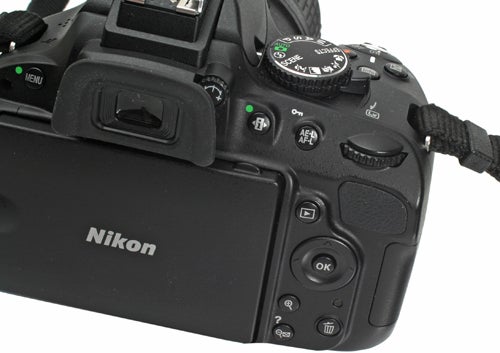
Like the D5000 and D3100, the D5100’s viewfinder covers 95% of the frame with a 0.78x magnification. Image stabilisation remains purely lens-based too, so you’ll have to invest in Nikon Vibration Reduction (VR) lenses if you want to take advantage of this. Thankfully, the supplied 18-55mm kit lens comes with this technology. Finally, dust-reduction takes the same two-stage Airflow dust channelling and sensor shake process of other Nikon DSLRs.
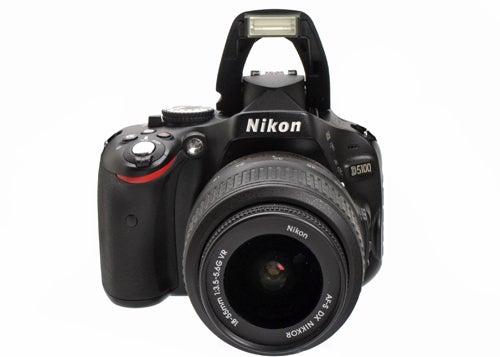
Straight out of the box, the most obvious hardware upgrade the D5100 enjoys over the D5000 is the large articulated LCD monitor dominating the back of the camera. While the D5000 also benefited from an articulated monitor, the D5100’s screen trumps it hands-down in every way – at threeinches it’s physically bigger, and at 921k-dots it offers a far superior resolution. And finally, with the hinge now located on the side of the camera (rather than at the bottom) it’s also much more flexible in use.
We thoroughly enjoyed using the new screen. Not only is it very sharp and detailed enough for composing and reviewing images on, we also found that the flexibility of movement it offers actively encouraged us to try new and unconventional angles while we were out shooting. 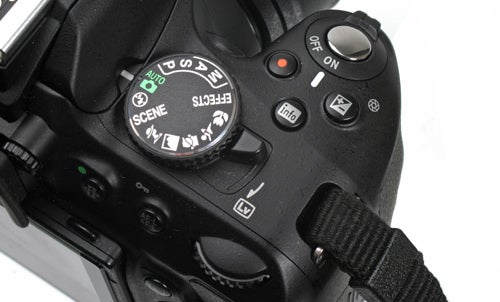
While the camera is being used in live view mode it’s possible to record movies, and here too the new model has received a boost over its predecessor, with the ability to record at 1920 x 1080 pixels, at 24 or 25fps (plus 30fps for NTSC regions). The D5000 could only record at a maximum 720p. The D5100’s improved abilities put it, on paper at least, in the same league as the Canon EOS 600D and Sony A580, with the Pentax K-r trailing behind somewhat with a maximum setting of 1080 x 720p at 25fps. The D5100’s movie files are recorded in the H.264 format
Audio is recorded in mono by default, although there is a 3.5mm jack on the side of the camera into which you can plug a stereo microphone. No doubt mindful of the increasing importance of being attached to the movie-making abilities of DSLRs, Nikon recently launched the ME-1 microphone (RRP £120), which attaches directly to the D5100 and other compatible Nikon DSLRs (ie – those with a mic input) via the hot-shoe.
In live view you can choose from three autofocus options, including an option for ‘always on’ Full-time-servo AF. By selecting this option, the D5100 will automatically keep the contents of the green box in the centre of the screen in focus. Full-time-servo AF isn’t available when using the camera in viewfinder mode, although you can select the Continuous-server option and nominate a single AF point, which will then maintain continual focus on that point as long as you keep the shutter button half-pressed. 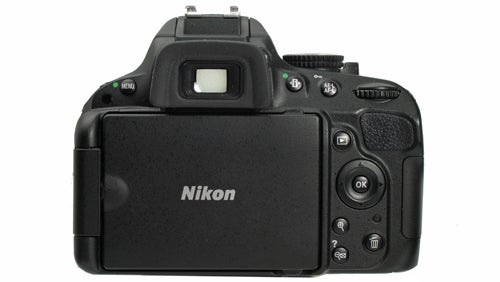
Another new feature that we touched on earlier is the addition of a Special Effects digital filters mode. The inclusion of filter effects on DSLRs is not all that new an idea; they were first seen on the Olympus E-30 back in 2008. Initially slow to catch on, the technology has recently seen a return to favour with Pentax and Canon both adding digital effects options to their own entry-level models. And now Nikon appears to be following suit. Accessed directly via the main Shooting mode dial the D5100’s eight individual filters are: Selective Colour, Miniature, Colour Sketch, Night Vision, Silhouette, High Key and Low Key.
In practice the effects work quite well, and we would imagine that many photographers, especially those who are new to the world of DSLRs, will have some fun with them. We certainly enjoyed playing with the Miniaturisation effect, although we were far less certain why anyone would purposely want to apply the kids’ crayon-like Colour Sketch effect to their images. The High and Low Key effects are very much of the ‘does what it says on the tin’ variety, while the Night Vision effect that boosts ISO to 102,400 and records images in monochrome can be used to good effect – and not just at night or in darkness either.
Fun as they might be, it’s worth bearing in mind that the special effects are no real match for what can be achieved using advanced image-editing software. And unlike like-minded offerings on competitor models such as the Canon 600D and Pentax K-r, the D5100’s filters cannot be individually tweaked either.
The D5100 also sports a new HDR feature which can be used to capture and merge two images shot at different exposures of up to 3EV. It only works for JPEG capture though and requires a quick trip into the main menu settings to activate unless you assign the Function button to it. For such a simplified function, the results can be quite impressive.
If you’d prefer to alter your images post-capture and in-camera, then the D5100 offers a fairly good selection of editing tools within the Retouch menu, including options to resize, straighten and crop images, or to apply a magic retouch wand. You can even to apply some of the special effects (for example, Miniaturisation and Colour Sketch) to regular JPEGs after capture. More useful still, is the ability to process Raw files into regular JPEGs in-camera.

One thing we were somewhat disappointed to discover missing from the D5100’s repertoire is built-in wireless flash control. We had asked Nikon about this at the D5100 launch event and were told it was going to be part of the feature set, so to find it isn’t was doubly disappointing. Given the surge of interest in creative lighting techniques using off-camera flash in recent years it’s a real let-down not to see it included, especially as rivals such as the Canon EOS 600D do offer it. Hopefully Nikon will take this on board for future releases. Similarly, the D5100 also lacks a depth-of-field preview button.
In terms of design, the D5100 is noticeably smaller and lighter than its predecessor. Curves are more accentuated too, giving it a less boxy, more refined look overall. It is very small though, and those with especially large hands may struggle to get three digits around the rubberised right-hand finger grip. That said, it remains a very light and comfortable camera to hold for prolonged periods of time. With the 18-55mm VRII kits lens attached it also feels a very well-balanced package, although swapping the kit lens for something bigger and heavier could easily unbalance it.
Thanks primarily to the placement of the articulated monitor’s hinge on the side of the camera, the D5100’s button layout has undergone a fairly dramatic reshuffle from where regular Nikon users might usually expect to find things. For example, all of the buttons located to the left-hand side of the screen on the D5000 (and pretty much every other Nikon DSLR besides) have had to shift elsewhere on the D5100, with some now found on the top plate and others located to the right-hand side of the monitor. 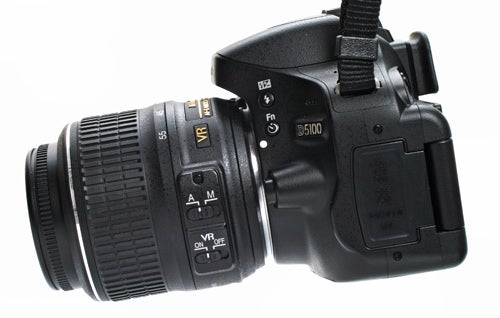
This isn’t the only change to controls. While the D-pad stays in its usual place, the dedicated live view button usually found on the back of the body on other Nikon DSLRs has disappeared altogether, with an all-new spring loaded lever extending from the Shooting mode dial on the top of the camera now responsible for activating and deactivating live view. Whereas previous Nikons usually placed the one-touch red-dot ‘movie record’ button on the back of the camera, it has now moved to the top, right next to the shutter release button.
While we appreciate that many of the control layout changes have been necessitated by the new side hinge, we found ourselves a bit disorientated at times, often reaching for buttons that weren’t quite where we expected them to be (pressing the ‘Review’ button when we wanted to start recording movies proved our most common mistake in this respect). Of course, for someone completely new to Nikon DSLRs this is unlikely to be a problem at all.
Despite many of the buttons moving around, one thing that remains very much in the D5100’s favour is the straightforward menu navigation system. Nikon has always excelled at simplifying menu navigation and the D5100 is no exception. This makes the D5100 really easy to use. While the main Menu button to the left of the viewfinder is used to access more complicated settings, the handy button to the right of the viewfinder can be called upon to access a single-screen menu of the most regularly used settings – from ISO to AF mode via Picture Controls and Metering mode. With all the options displayed clearly on the monitor, accessing and changing these key settings with the D-pad proves both easy and intuitive, becoming almost second-nature before long.
DSLR newcomers trying to gain a better understanding of what all the various features and functions do are well catered for too, with a simple tap of the ‘?’ button bringing up short snippets of easy-to-understand information on what each of the selected settings and functions does. It’s not quite as simplified as the Guide Mode of the D3100, but still a useful addition.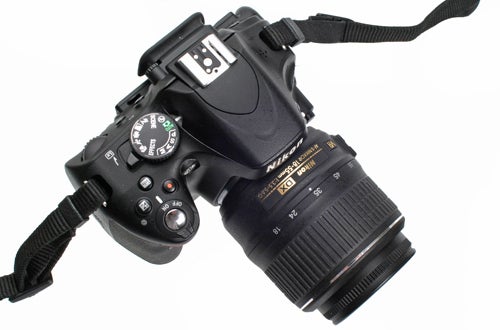
Turning to performance, we found the D5100 to be an extremely competent camera overall. When switched on the camera is instantly ready to operate, although it’ll generally take half a second or so for the autofocus to lock on.
We found the D5100’s 11-point phase-detect system to be generally fast enough when shooting through the viewfinder, although it is worth reiterating that because the D5100 lacks an internal AF motor, AF performance is very much determined by the choice of lens attached – in this case the supplied 18-55mm VR kit lens. This is by no means the fastest optic we’ve ever used, but should prove fast enough for the overwhelming majority of situations.

Ideally, we would have liked to have seen the diamond-like formation of the 11 AF points cover a bit more of the viewfinder, especially on the horizontal plane, as they’re a little bunched in together towards the centre of the viewfinder. A few more cross-type sensors would be really helpful too, especially if, like us, you prefer to determine your own point of focus using Single-point AF rather than letting the camera decide via Auto-area AF. One other slightly annoying thing we found is that, while using Single-point AF, we couldn’t find an easy way to lock down our chosen point, making too easy to accidentally change with a stray thumb on the D-pad.
Using the camera in live view, we found the contrast-detect AF system to be surprisingly quick – far quicker than the Canon EOS 600D by comparison, and with much less back-and-forth focus-hunting involved. Used in ‘always on’ full-time-server AF mode we found the D5100 fairly quick to respond to focal distance shifts in brightly lit situations, although it does get gradually slower (with an accompanying increase in annoying focus-hunt) the less light is available. We were impressed by how quickly and smoothly the D5100 reacts to extreme changes in light, such as when panning from bright sunlight into darker shadows.
As with most DSLRs fitted with a built-in microphone, lens noise can be a bit of an issue while recording movies with the camera picking up the internal whirring of the autofocus system – especially when filming in a quiet location. If you really want to cut this out then your best bet is to use a directional microphone, such as the recently announced Nikon ME-1. Alternatively, you can set the camera to manual focus and adjust it yourself, though this option does take some practice to master.
As mentioned earlier, we found the LCD monitor really good to work with when composing images. Indoors or in the shade outdoors the screen remains immensely sharp, bright and colourful, with generous viewing angles. And while it’s hard to see past your own reflection when shooting directly into sunlight, shooting with the sun on your back isn’t nearly so much of a problem.
While general handling, ease-of-use and AF performance all score valuable points for the D5100, image quality remains the camera’s trump card. With the editable Picture Control settings it’s possible to dial in as much (or as little) saturation, contrast and sharpness as you want to get your images looking exactly how you want them to, with the D5100 proving consistently accurate in its calculations.
Despite using the cheaper metering module of the D3100, the D5100 remains reliable in all lighting conditions, with no tendency to either over- or under-expose. When faced with high-contrast scenes beyond the spectrum of its dynamic range, Nikon’s proprietary Active D-Lighting technology can be engaged to preserve more highlight detail. There are four steps in total from ‘low’ to ‘extra high’, along with ‘automatic’ and ‘off’ options. The technology works well and often proves useful, although some caution is advised with the ‘extra high’ setting as it can produce unrealistic-looking images.
While the 18-55mm VR kit lens isn’t the sturdiest or
sharpest optic ever produced by Nikon, it does provide very good value for money and should prove more than adequate for general use and certainly as a starting point for first-time DSLR users.
Likewise, the 16-megaopixel sensor is able to resolve plenty of detail, even at higher ISO settings. While this might reasonably be expected at low to mid-sensitivity settings of between ISO 100 and 800, we were especially impressed with the mid to high settings of ISO 1600 to 3200, where the D5100 was able to retain plenty of detail without displaying excessive noise. ISO 6400 marks the point at which noise does become more visibly intrusive, especially in shadow areas, although images still look very good. At the higher and extended settings of ISO 12,800 and 25,600 noise proves far more intrusive, with a corresponding loss of fine detail. In fairness, this is to be expected.
Put simply, the D5100 is a hugely adaptable camera that takes excellent pictures, with overall image quality consistently matching that of the more expensive D7000.
Verdict
The D5100 provides several notable upgrades over the D5000 making it, in our opinion, a far more attractive package than its predecessor was at launch. Significantly smaller and lighter, it’s also easy to use, offers good performance and is capable of delivering consistently good results, both in stills and movie mode.
Our only quibbles, such as they are, are fairly minor and limited to the exclusion of useful advanced entry-level tools such as the ability to the pop-up flash as a wireless commander and the omission of a depth-of-field preview button. Both of these would ultimately prove more useful and give the camera more longevity than any of the Special Effects shooting modes.
Overall though, the D5100 remains a great camera to use that’s capable of delivering stunning images. If you’re in the market for an advanced entry-level DSLR be sure to add it to your shortlist.
Full ISO test scene
ISO 100
ISO 200
ISO 400
ISO 800
ISO 1600
ISO 3200
ISO 6400
ISO 12800
ISO 25800

The following photo demonstrates the Nikon D5100’s tilt shift feature.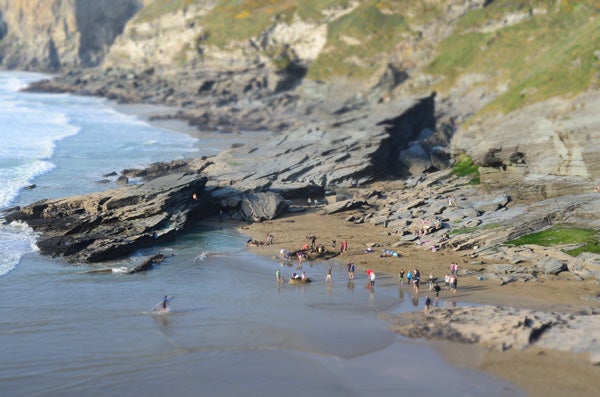
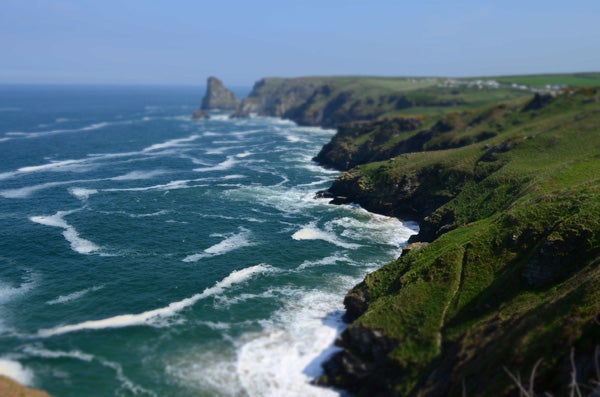
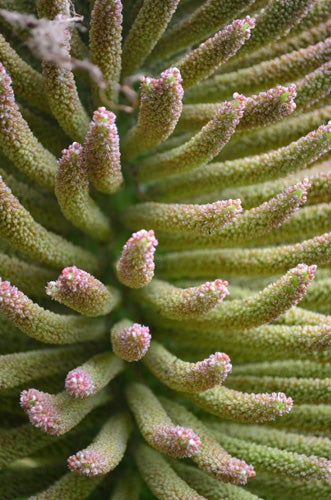


Trusted Score
Score in detail
-
Value 8
-
Design & Features 8
-
Image Quality 9
-
Build Quality 8
Features
| Camera type | Digital SLR |
| Megapixels (Megapixel) | 16.2 Megapixel |
| Optical Zoom (Times) | 3.1x |
| Image Sensor | CMOS |
| Optical focal length | NA |
| Image Stabilisation | Optical |
| LCD Monitor | 3 in |
| Flash modes | Auto Flash, Flash OFF, Flash ON, Slow Sync, Rear-curtain Sync, Red-eye Reduction, Flash Exposure Compensation |
| Video (max res/format) | 1920 x 1080 |

